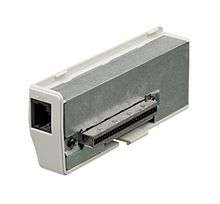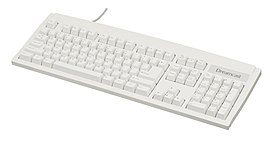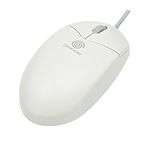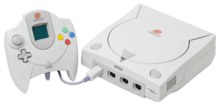Dreamcast online functionality
The Dreamcast is a home video game console by Sega, the first one introduced in the sixth generation of video game consoles. With the release of the Dreamcast in 1998 amid the dot-com bubble and mounting losses from the failure of its predecessor, the Sega Saturn, Sega made a major gamble in attempting to take advantage of the growing public interest in the Internet by including online capabilities in the console as a selling point. As such, the Dreamcast was the first console to include a built-in modem for Internet support and online play.a Sega would end up leaning heavily into the online capabilities to sell the Dreamcast as hype grew for Sony's then-upcoming competitor, the PlayStation 2, which also promised online gaming in addition to its DVD capabilities.
To create further incentive for use of the Dreamcast's online capabilities, Sega went beyond the scope of their prior online ventures and invested heavily in the development of unified online services for it, a concept that predated former partner Microsoft's Xbox Live service by a few years. Sega also predated Microsoft in pioneering the concept of downloadable content for games released on a console, though it was hampered by the small memory of the VMU. Despite the foresight Sega had in the emergence of broadband Internet access by making the modem modular and upgradeable with a broadband adapter, the services mainly supported dial-up Internet access throughout their lifetimes; only in Japan did broadband service arrive for the Dreamcast before Sega discontinued it in 2001, abandoning the console business altogether with its transition to third-party publishing. The services were gradually discontinued by Sega in the subsequent years; the last remaining service lingered on in Japan before it was shut down in 2007. In response, hobbyists have revived parts of the online services by creating private servers for a handful of games that had their official servers shut down.
Hardware

Sega produced two networking accessories for the Dreamcast worldwide, one for dial-up connections and one for broadband connections. A third accessory, also intended for broadband connections, was only available in Japan. All adapters are visually similar; however, the first accessory includes a telephone jack while the latter two accessories include an Ethernet jack instead. The adapters attach flush to an expansion port, named "Extension," on the side of the Dreamcast.[1] Sega also produced a keyboard and a computer mouse for easier navigation of the Internet on the Dreamcast.[2]
Modem Adapter

The Modem Adapter is a dial-up modem that was included with all Dreamcast consoles sold worldwide except for Brazil, where it was excluded due to the high price of the console there.[3] As a result, the adapter was sold separately only in Brazil, where it was sold as the Dreamcast Link and retailed for R$49.99.[4] European and early Japanese models came with a 33.6 kbit/s modem, while North American and most Japanese models included a 56 kbit/s modem.[1][5][6] To produce the modem, Sega partnered with Rockwell International through its semiconductor division, which was spun off as Conexant on January 4, 1999.[7][8]
There are two models of the modem adapter, 670-14140A and 670-14140B. The "A" model can use power from the Dreamcast game console to allow it to operate without the need of power from the telephone line. The "B" model does not use power from the Dreamcast; thus, it is dependent on the power from the telephone line or a modem that runs power through the telephone line.
Custom dial-up server
There are multiple ways to create a server between a Dreamcast and a personal computer (PC) using the standard modem which allows the Dreamcast to share the PC's network connection.
- PC-DC Server using Windows 95/98.[9]
- PC-DC Server using a Linux distribution like Ubuntu.
- Dial-up Network by using a LAN modem (like a Netopia R2020) with a telephone line simulator.[10]
- PC-DC Server using Dreamcast Now software on a Raspberry Pi.[11]
Broadband Adapter

The Broadband Adapter is a network adapter that was released as a separate accessory for the Dreamcast in Japan on July 15, 2000, retailing at ¥8,800;[12] the United States followed suit on January 9, 2001, with a retail price of USD$59.95.[13][14][15] The adapter was never bundled with any console, and in the United States, the adapter was only available in Sega's online store for a few months after its release; it appeared in retail stores starting in March of that year.[13] Though it was never released in Europe, use of an American (or Japanese) adapter on a PAL system is possible since the adapter is not region coded.[1] Only a few hundred thousand were produced as worldwide broadband adoption was still poor at the time.[6] Due to the adapter's launch late in the lifespan of the Dreamcast, only a handful of games supported the adapter as developers had to explicitly include support for the adapter in their games; the games that did support it were able to take advantage of the 10 and 100 Mbit speeds provided by the adapter.[15] However, it also had an unintended consequence of much faster Dreamcast GD-ROM copying, leading to a dramatic increase in game piracy towards the end of the console's North American lifespan.[16]
It is a common misconception that the Broadband Adapter was released with two model numbers (HIT-0400 for the US, and HIT-0401 for Japan); in actuality, both Japan and US models have the code HIT-0400 and use a Realtek 8139 chip. The code HIT-0401 refers to the Japanese model's packaging and documentation, while the code HIT-0400 refers to the adapter hardware.[17] Besides the Broadband Adapter, Sega also released the LAN Adapter in 1999 for sale in Japan only. It is inferior compared to the Broadband Adapter as it supports only the low 10 Mbit speed with the use of a Fujitsu MB86967 chip. The LAN Adapter was also not compatible with any online Dreamcast games and worked only with the included Japanese browser disk.[1][6][17]
Due to the decline of dial-up networking and the rise of the more modernized, faster LAN connection, the Broadband Adapter has reached very high demand over the pre-packaged Modem Adapter. Combined with the scarcity of the adapter, this has resulted in highly inflated prices for it; as early as 2004, retailers such as eBay sold the adapter alone for around $100 to $150, and it still regularly sells for more than the Dreamcast itself. Some games are still playable online via the Broadband Adapter through private servers, such as Phantasy Star Online, Toy Racer, and Quake III Arena.[6][17]
Online services
Dricas (Japan)
| Developer | Sega, ISAO Corporation |
|---|---|
| Type | Online service |
| Launch date | April 28, 1998 |
| Discontinued | September 28, 2007 |
| Platform(s) | Dreamcast |
| Website | www.dricas.com at the Wayback Machine (archived October 19, 2000) |
Dricas was an Internet service intended for Dreamcast consoles in Japan. The service launched the week of April 28, 1998, with only a few features such as e-mail available; the feature set expanded in the months preceding the Dreamcast's launch in Japan on November 27, 1998.[18] Much of its infrastructure was developed by ISAO Corporation, which was spun-off from Sega on November 26, 1999.[19] Its accompanying web browser, DreamPassport, added the ability to send images and videos through e-mail and video chat via the Dreameye accessory, which was only sold in Japan.[20] Dricas persisted until March 7, 2000, when the service was consolidated into ISAO's multi-platform online service, isao.net.[21] Broadband support arrived for the service a few months later on July 15 of that year, launching with the debut of the Broadband Adapter in Japan.[12] Isao.net maintained online services and game servers for the Dreamcast until Sega ceased the online servers for the last remaining Dreamcast game, Phantasy Star Online, along with its GameCube port on March 31, 2007.[22] Sega ultimately terminated the Dreamcast-dedicated portion of the isao.net service on September 28, 2007,[23] eliminating the last remaining vestige of Sega's ambitious plan for online gaming with the Dreamcast close to ten years after the initial launch of Dricas.
SegaNet (United States)
| Developer | Sega, Genuity |
|---|---|
| Type | Online service |
| Launch date | September 7, 2000 |
| Discontinued | July 20, 2001 (Online service) September 30, 2003 (Online game servers) |
| Platform(s) | Dreamcast |
| Website | www.sega.net at the Wayback Machine (archived June 2, 2001) |
SegaNet was a short-lived Internet service geared for dial-up-based online gaming on the Dreamcast game console in the United States. The service was created by Sega in collaboration with GTE through its GTE Internetworking division,[24] which was spun-off from GTE and renamed Genuity in the midst of development as GTE merged with Bell Atlantic to form Verizon Communications on June 30, 2000.[25][26] As such, it was Genuity that ended up providing the dial-up service and network infrastructure.[27][28] Microsoft also participated with Sega in the development of the service until they terminated their relationship just a few months before its launch over differences in its direction.[29]
As a replacement for Sega's original PC-only online gaming service, Heat.net,[30] SegaNet was initially quite popular when it launched on September 7, 2000.[31] Just over a month after launch, by October 27, 2000, SegaNet had 1.55 million Dreamcast consoles registered online, including 750,000 in Japan, 400,000 in North America, and 400,000 in Europe.[32] This was somewhat surprising given that Sega initially set a monthly subscription fee of USD$21.95, relatively expensive compared to other Internet service providers (ISPs) of the time. However, it was unavailable outside of the contiguous United States; support for Canada, Alaska, and Hawaii was planned, but never realized.[27][28][33] Unlike a standard ISP, game servers would be connected directly into SegaNet's internal network, providing very low connection latency between the consoles and servers along with standard Internet access via the included PlanetWeb browser.[6][34]
SegaNet originally offered a rebate for a free Dreamcast with a two-year contract along with a free keyboard to encourage sales of the console.[34][35] However, with pressure mounting from Sony's PlayStation 2 and the announcements of Microsoft's Xbox and Nintendo's GameCube, sales of the Dreamcast continued to drop and, on July 20, 2001, Sega announced they would discontinue the service just less than 11 months after launch.[36] At this point, all subscribers were given the option to transfer their accounts to EarthLink.[37][38] Sega continued to operate the online game servers, initially removing the subscription fee for accessing them before reinstating it, albeit reduced to $9.95 per month, on November 1 of that year.[39] They permanently eliminated the required subscription at the beginning of August 2002 with the intention of shutting down the servers by the end of that year;[40][41] however, they decided to extend the service by six months, officially ending online support for most Dreamcast games effective June 2003.[42] Sega continued to provide online support for Phantasy Star Online and Phantasy Star Online Ver. 2 until September 30, 2003; the online servers for both games were shut down at that point, officially ceasing online gaming on the Dreamcast in the United States.[43]
Dreamarena (Europe)
 | |
| Developer | Sega |
|---|---|
| Type | Online service |
| Launch date | October 14, 1999 |
| Discontinued | March 2002 |
| Platform(s) | Dreamcast |
Dreamarena was a free dial-up-based online gaming service provided for all Dreamcast consoles in Europe, launching with the debut of the Dreamcast in Europe on October 14, 1999.[44] The service was created and operated for Sega Europe by a partnership between ICL, BT and various ISPs; ICL developed the web sites and software, with BT providing the dial-up capabilities and network infrastructure,[44][45] and the ISPs (one for each country) providing the Internet dial-up connection and telephone service. The service was free, and the game servers hosted within it could not otherwise be accessed from the Internet. Some games released in Europe after the Dreamcast was discontinued did not include the online functionality present in other regions, infuriating some consumers who anticipated using the online features.[5] Dreamarena went through two revisions, with the final one coinciding with DreamKey 3.0. Dreamarena was discontinued in March 2002, but online functions for the Dreamcast continued to run until the beginning of March 2003.
Although people could change their ISP settings thanks to American online games like Quake III Arena, European Dreamcast web browsers DreamKey 1.0 and 1.5 didn't allow users to input their own ISP settings. After the end of Dreamarena, Sega offered to send DreamKey 3.0/3.1 free from Sega-Europe's website, allowing users to replace the Dreamarena ISP settings with their own ISP settings,[5] to continue to browse the web and to play online games until the discontinuation of online services.
Supported games
Despite the emphasis of online gaming by Sega, no games supported online play at launch despite a handful of games offering free downloadable content (DLC) to store on a VMU, including Sonic Adventure.[5][46] This caused much ire among consumers such that complaints were filed to the BBC's Watchdog programme and the Independent Television Commission (ITC) in the United Kingdom, accusing Sega of misleading advertising. The ITC subsequently forced Sega to remove references to online gaming in Dreamcast advertisements, with Sega deciding to switch European advertising agencies from WCRS to Bartle Bogle Hegarty as a result of the controversy.[47][48] The first game to support online play was ChuChu Rocket!, which first released in Japan on November 11, 1999.[5][49]
Online games on the Dreamcast initially allowed free access to their game servers with expectations of cost offsetting through SegaNet subscriptions and game sales. Phantasy Star Online Ver. 2 was one of the exceptions to the free access, charging a monthly fee throughout the existence of its official servers. There are some private servers still online that are playable with the following games: Phantasy Star Online Ver. 1 and Phantasy Star Online Ver. 2, Sega Swirl, 4x4 Evolution, Quake III Arena, Maximum Pool, Planet Ring, Toy Racer, Starlancer, ChuChu Rocket!, The Next Tetris On-line Edition, PBA Tour Bowling 2001, Sonic Adventure, Alien Front Online, Worms World Party, Racing Simulation 2 On-line: Monaco Grand Prix, POD: Speedzone, Ooga Booga, World Series Baseball 2K2, Jet Set Radio, NCAA College Football 2K2: Road to the Rose Bowl, NFL 2K1, NFL 2K2, NBA 2K1, and NBA 2K2, with more games upcoming.[50][51][52]
Notes
- a.^ The Apple Bandai Pippin, released in 1996, included a 14.4 kbit/s modem; however, it was external and plugged in via a nine-pin mini-DIN connector.
See also
Competing online services
Prior online ventures by Sega
- Sega Meganet for the Mega Drive (Japan, Brazil)
- Sega Channel for the Genesis (United States)
- Sega NetLink for the Saturn
References
- "Dreamcast Online - Getting Online with your Sega Dreamcast". OnlineConsoles. Retrieved 2020-06-17.
- Williamson, Colin (18 August 2000). "Dreamcast Keyboard and Mouse (Import)". IGN. Ziff Davis. Retrieved 23 June 2020.
- Oliveira, Otavio Dias de (September 11, 1999). "Sega Dreamcast estoura nas lojas". Folha de S.Paulo (in Portuguese). 79 (25728). São Paulo: Grupo Folha. pp. 5–3. ISSN 1414-5723. Archived from the original on March 3, 2016.
- "Dreamcast - Acessórios". Tectoy (in Portuguese). Archived from the original on 11 November 2001. Retrieved 20 June 2020.
- Pettus, Sam; Munoz, David; Williams, Kevin; Barroso, Ivan (2013-12-20). Service Games: The Rise and Fall of SEGA: Enhanced Edition. Smashwords Edition. ISBN 978-1-311-08082-0.
- Carless, Simon (2004). Gaming Hacks. O'Reilly Media. pp. 210–211. ISBN 978-0-596-00714-0.
- Lanser, Jonathan (8 July 1999). "Sega Makes Game With Its Own Internet Service". Chicago Tribune. Tribune Publishing. Retrieved 23 June 2020.
- Lapedus, Mark (10 November 1998). "Rockwell Semi spin-off Conexant will target communications IC market". EE Times. AspenCore. Retrieved 23 June 2020.
- "PC-Dreamcast Server". www.maturion.de. Retrieved 2020-06-23.
- "New method for connecting Dreamcast! - Dreamcast-Talk.com". www.dreamcast-talk.com. Retrieved 2020-06-23.
- "DreamPi 1.1 Released - with Dreamcast Now! - Dreamcast-Talk.com". www.dreamcast-talk.com. Retrieved 2020-06-23.
- Williams, Martyn (12 June 2000). "Sega to launch broadband service in Japan". CNN. Retrieved 22 June 2020.
- Satterfield, Shane (4 January 2001). "Dreamcast Broadband Adapter Will Be Available Online". GameSpot. CBS Interactive. Retrieved 22 June 2020.
- Ahmed, Shahed (11 January 2001). "Sega Releases the Dreamcast Broadband Adapter". GameSpot. CBS Interactive. Retrieved 23 June 2020.
- Olafson, Peter (2001-01-25). "NEWS WATCH; Faster Modem Makes Gamers Quicker on the Trigger". The New York Times. ISSN 0362-4331. Retrieved 2020-06-23.
- Whitehead, Dan (2010-04-14). "Banging the DRM • Page 5". Eurogamer. Gamer Network. Retrieved 2020-06-23.
- "NetBSD/dreamcast Frequently Asked Questions". The NetBSD Project. Retrieved 2020-06-17.
- Ohbuchi, Yutaka (28 April 1998). "Sega's Dricas Site Opens Up". GameSpot. CBS Interactive. Retrieved 20 June 2020.
- "社名変更のお知らせ" [Notice of company name change] (Press release) (in Japanese). ISAO Corporation. 26 November 2000. Archived from the original on 23 January 2001.
- "IGNDC Talks Dreameye With Sega". IGN. Ziff Davis. 6 March 2000. Retrieved 22 June 2020.
- "Dricas.com". Dricas. Archived from the original on 20 June 2000. Retrieved 23 June 2020.
- "「PHANTASY STAR ONLINE」 ドリームキャスト版およびゲームキューブ版 終了記念キャンペーンに関するご案内" [Information on "PHANTASY STAR ONLINE" Dreamcast Edition and GameCube Edition End Commemorative Campaign] (Press release) (in Japanese). ISAO Corporation. 8 February 2007. Archived from the original on 10 August 2007.
- "Dreamcast向けゲームソフト専用サイト一部終了のご案内" [Information on the end of the site for exclusive use of game software for Dreamcast]. isao.net (in Japanese). Archived from the original on 11 October 2007. Retrieved 21 June 2020.
- "Sega Announces Formation of New Company, Sega.com, Inc" (Press release). Sega. 4 April 2000. Retrieved 20 June 2020.
- Pappalardo, Denise (10 April 2000). "GTE, others play the name game". Network World. Vol. 17 no. 15. IDG. p. 12. ISSN 0887-7661.
- "Bell Atlantic, GTE merger completed". The Oklahoman. Gannett. 1 July 2000. Retrieved 21 June 2020.
- "Sega Seeks Net Profits". Wired. Condé Nast. 2000-09-07. ISSN 1059-1028. Retrieved 2020-06-22.
- Oliver, Tristan (6 August 2000). "No SegaNet for Canada?". TSSZ News. Archived from the original on 19 November 2019. Retrieved 20 June 2020.
- Thurrott, Paul (2000-06-05). "Microsoft, Sega end gaming relationship". IT Pro Today. Informa. Retrieved 2020-06-18.
- Horowitz, Ken (2016-10-21). Playing at the Next Level: A History of American Sega Games. McFarland. p. 269. ISBN 978-0-7864-9994-6.
- Campbell, Christine (11 September 2000). "Sega isn't playing around with SegaNet". CNN. Retrieved 20 June 2020.
- "Sega Announces New Corporate Focus On Networked Entertainmnet" (PDF). segasammy.co.jp/. October 27, 2000. Archived from the original (PDF) on June 30, 2013. Retrieved June 12, 2019.
- "Dreamcast $50 rebate Q&A". AnandTech Forums. 2000-09-04. Retrieved 2020-06-17.
- "Sega to Unveil Online Gaming Strategy". The New York Times. Reuters. 2000-04-04. ISSN 0362-4331. Retrieved 2020-06-23.
- Fielder, Lauren (26 April 2000). "Free Dreamcast for Sega's New ISP". GameSpot. CBS Interactive. Retrieved 22 June 2020.
- Sklens, Mike (2001-07-20). "SegaNet shutting down!". Nintendo World Report. Retrieved 2020-06-20.
- "Seganet Links Up With Earth". IGN. Ziff Davis. July 30, 2001. Retrieved June 12, 2019.
- "Sega Turns to Earth for Internet Link". IGN. Ziff Davis. July 20, 2001. Archived from the original on April 27, 2003. Retrieved June 12, 2019.
- Pham, Alex (25 October 2001). "Sega to Charge for SegaNet Access". Los Angeles Times. Retrieved 20 June 2020.
- Vinciguerra, Rob (August 2, 2002). "SegaNet: no longer pay-to-play". dricasworld.com. Archived from the original on June 3, 2004. Retrieved June 12, 2019.
- " "SegaNet is FREE Now but Nobody is Playing". DreamStation.cc. August 17, 2002. Archived from the original on June 26, 2006. Retrieved June 12, 2019.
- "Playing Online". Sega. Archived from the original on 22 June 2003. Retrieved 17 June 2020.
- "Playing Online". Sega. Archived from the original on 14 October 2003. Retrieved 17 June 2020.
- "Sega's console dream". BBC News. 14 October 1999. Retrieved 2020-06-23.
- Hara, Yoshiko (14 May 1999). "British Telecom to bring Net access to Sega's Dreamcast". EE Times. AspenCore. Retrieved 23 June 2020.
- Hansen, Dustin (2016-11-22). Game On!: Video Game History from Pong and Pac-Man to Mario, Minecraft, and More. Feiwel & Friends. p. 91. ISBN 978-1-250-08096-7.CS1 maint: date and year (link)
- Hall, Emma (25 February 2000). "BBH lands pounds 60m Sega Europe task". Campaign. Haymarket Publishing. Retrieved 20 June 2020.
- Jardine, Alexandra (9 March 2000). "Dreamcast TV ad rapped for false e-gaming claims". Campaign. Haymarket Publishing. Retrieved 20 June 2020.
- Williamson, Colin (15 November 1999). "Chu Chu Rocket (Import)". IGN. Ziff Davis. Retrieved 20 June 2020.
- "ChuChu Rocket Is Back Online!". dreamcastlive. June 7, 2016. Archived from the original on June 12, 2016. Retrieved June 12, 2019.
- "Dreamcast Live Games". dreamcastlive.net. Retrieved June 12, 2019.
- Charnock, Tom. "POD 2 Is Back Online". Retrieved June 12, 2019.



